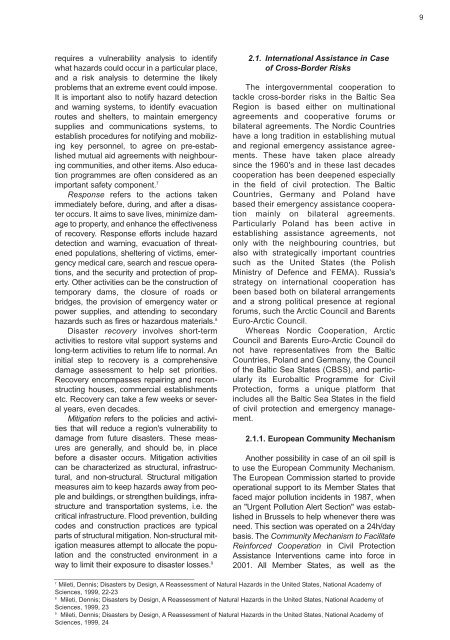Cross-Border Risks in the Baltic Sea Region: Lessons to ... - Helsinki.fi
Cross-Border Risks in the Baltic Sea Region: Lessons to ... - Helsinki.fi
Cross-Border Risks in the Baltic Sea Region: Lessons to ... - Helsinki.fi
Create successful ePaper yourself
Turn your PDF publications into a flip-book with our unique Google optimized e-Paper software.
9<br />
requires a vulnerability analysis <strong>to</strong> identify<br />
what hazards could occur <strong>in</strong> a particular place,<br />
and a risk analysis <strong>to</strong> determ<strong>in</strong>e <strong>the</strong> likely<br />
problems that an extreme event could impose.<br />
It is important also <strong>to</strong> notify hazard detection<br />
and warn<strong>in</strong>g systems, <strong>to</strong> identify evacuation<br />
routes and shelters, <strong>to</strong> ma<strong>in</strong>ta<strong>in</strong> emergency<br />
supplies and communications systems, <strong>to</strong><br />
establish procedures for notify<strong>in</strong>g and mobiliz<strong>in</strong>g<br />
key personnel, <strong>to</strong> agree on pre-established<br />
mutual aid agreements with neighbour<strong>in</strong>g<br />
communities, and o<strong>the</strong>r items. Also education<br />
programmes are often considered as an<br />
important safety component. 7<br />
Response refers <strong>to</strong> <strong>the</strong> actions taken<br />
immediately before, dur<strong>in</strong>g, and after a disaster<br />
occurs. It aims <strong>to</strong> save lives, m<strong>in</strong>imize damage<br />
<strong>to</strong> property, and enhance <strong>the</strong> effectiveness<br />
of recovery. Response efforts <strong>in</strong>clude hazard<br />
detection and warn<strong>in</strong>g, evacuation of threatened<br />
populations, shelter<strong>in</strong>g of victims, emergency<br />
medical care, search and rescue operations,<br />
and <strong>the</strong> security and protection of property.<br />
O<strong>the</strong>r activities can be <strong>the</strong> construction of<br />
temporary dams, <strong>the</strong> closure of roads or<br />
bridges, <strong>the</strong> provision of emergency water or<br />
power supplies, and attend<strong>in</strong>g <strong>to</strong> secondary<br />
hazards such as <strong>fi</strong>res or hazardous materials. 8<br />
Disaster recovery <strong>in</strong>volves short-term<br />
activities <strong>to</strong> res<strong>to</strong>re vital support systems and<br />
long-term activities <strong>to</strong> return life <strong>to</strong> normal. An<br />
<strong>in</strong>itial step <strong>to</strong> recovery is a comprehensive<br />
damage assessment <strong>to</strong> help set priorities.<br />
Recovery encompasses repair<strong>in</strong>g and reconstruct<strong>in</strong>g<br />
houses, commercial establishments<br />
etc. Recovery can take a few weeks or several<br />
years, even decades.<br />
Mitigation refers <strong>to</strong> <strong>the</strong> policies and activities<br />
that will reduce a region's vulnerability <strong>to</strong><br />
damage from future disasters. These measures<br />
are generally, and should be, <strong>in</strong> place<br />
before a disaster occurs. Mitigation activities<br />
can be characterized as structural, <strong>in</strong>frastructural,<br />
and non-structural. Structural mitigation<br />
measures aim <strong>to</strong> keep hazards away from people<br />
and build<strong>in</strong>gs, or streng<strong>the</strong>n build<strong>in</strong>gs, <strong>in</strong>frastructure<br />
and transportation systems, i.e. <strong>the</strong><br />
critical <strong>in</strong>frastructure. Flood prevention, build<strong>in</strong>g<br />
codes and construction practices are typical<br />
parts of structural mitigation. Non-structural mitigation<br />
measures attempt <strong>to</strong> allocate <strong>the</strong> population<br />
and <strong>the</strong> constructed environment <strong>in</strong> a<br />
way <strong>to</strong> limit <strong>the</strong>ir exposure <strong>to</strong> disaster losses. 9<br />
2.1. International Assistance <strong>in</strong> Case<br />
of <strong>Cross</strong>-<strong>Border</strong> <strong>Risks</strong><br />
The <strong>in</strong>tergovernmental cooperation <strong>to</strong><br />
tackle cross-border risks <strong>in</strong> <strong>the</strong> <strong>Baltic</strong> <strong>Sea</strong><br />
<strong>Region</strong> is based ei<strong>the</strong>r on mult<strong>in</strong>ational<br />
agreements and cooperative forums or<br />
bilateral agreements. The Nordic Countries<br />
have a long tradition <strong>in</strong> establish<strong>in</strong>g mutual<br />
and regional emergency assistance agreements.<br />
These have taken place already<br />
s<strong>in</strong>ce <strong>the</strong> 1960's and <strong>in</strong> <strong>the</strong>se last decades<br />
cooperation has been deepened especially<br />
<strong>in</strong> <strong>the</strong> <strong>fi</strong>eld of civil protection. The <strong>Baltic</strong><br />
Countries, Germany and Poland have<br />
based <strong>the</strong>ir emergency assistance cooperation<br />
ma<strong>in</strong>ly on bilateral agreements.<br />
Particularly Poland has been active <strong>in</strong><br />
establish<strong>in</strong>g assistance agreements, not<br />
only with <strong>the</strong> neighbour<strong>in</strong>g countries, but<br />
also with strategically important countries<br />
such as <strong>the</strong> United States (<strong>the</strong> Polish<br />
M<strong>in</strong>istry of Defence and FEMA). Russia's<br />
strategy on <strong>in</strong>ternational cooperation has<br />
been based both on bilateral arrangements<br />
and a strong political presence at regional<br />
forums, such <strong>the</strong> Arctic Council and Barents<br />
Euro-Arctic Council.<br />
Whereas Nordic Cooperation, Arctic<br />
Council and Barents Euro-Arctic Council do<br />
not have representatives from <strong>the</strong> <strong>Baltic</strong><br />
Countries, Poland and Germany, <strong>the</strong> Council<br />
of <strong>the</strong> <strong>Baltic</strong> <strong>Sea</strong> States (CBSS), and particularly<br />
its Eurobaltic Programme for Civil<br />
Protection, forms a unique platform that<br />
<strong>in</strong>cludes all <strong>the</strong> <strong>Baltic</strong> <strong>Sea</strong> States <strong>in</strong> <strong>the</strong> <strong>fi</strong>eld<br />
of civil protection and emergency management.<br />
2.1.1. European Community Mechanism<br />
Ano<strong>the</strong>r possibility <strong>in</strong> case of an oil spill is<br />
<strong>to</strong> use <strong>the</strong> European Community Mechanism.<br />
The European Commission started <strong>to</strong> provide<br />
operational support <strong>to</strong> its Member States that<br />
faced major pollution <strong>in</strong>cidents <strong>in</strong> 1987, when<br />
an "Urgent Pollution Alert Section" was established<br />
<strong>in</strong> Brussels <strong>to</strong> help whenever <strong>the</strong>re was<br />
need. This section was operated on a 24h/day<br />
basis. The Community Mechanism <strong>to</strong> Facilitate<br />
Re<strong>in</strong>forced Cooperation <strong>in</strong> Civil Protection<br />
Assistance Interventions came <strong>in</strong><strong>to</strong> force <strong>in</strong><br />
2001. All Member States, as well as <strong>the</strong><br />
7<br />
Mileti, Dennis; Disasters by Design, A Reassessment of Natural Hazards <strong>in</strong> <strong>the</strong> United States, National Academy of<br />
Sciences, 1999, 22-23<br />
8<br />
Mileti, Dennis; Disasters by Design, A Reassessment of Natural Hazards <strong>in</strong> <strong>the</strong> United States, National Academy of<br />
Sciences, 1999, 23<br />
9<br />
Mileti, Dennis; Disasters by Design, A Reassessment of Natural Hazards <strong>in</strong> <strong>the</strong> United States, National Academy of<br />
Sciences, 1999, 24
















